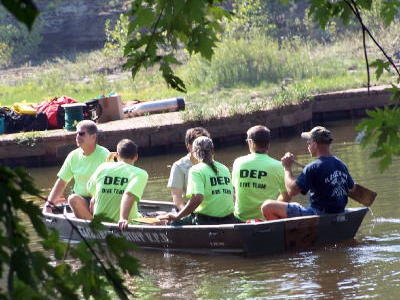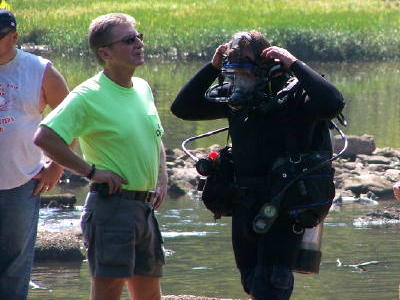HISTORIC WELLS LOCK AND DAM GETTING SOME HELP

(Photos by Chris Ross)
The historic Wells Lock and Dam in Elizabeth is getting some assistance.
The Division of Natural Resources is taking steps to keep a section of the dam on the Little Kanawha River from failing.
The agency owns the former lock and dam near Elizabeth and a recent inspection report shows a lock chamber wall could fail.
Brian Long with the Department of Environmental Protection's Dam Safety office says DNR crews are filling the lock chamber this week with rock as a temporary measure.
Long says a failure doesn't pose a risk downstream, but property, roadways and utilities upstream could be affected if the river suddenly lost water.
Long says water pressure upstream keeps the river bank from collapsing.
Wirt County Commissioner Robert Lowe says keeping the dam in place is important to the area. Lowe has led the effort for several years to keep the structure from collapsing.

A team of Department of Environmental Protection divers and inspectors recently completed a second review of the 19th Century dam.
The review came as a result of requests from the Wirt County Commission and the U.S. Army Corps of Engineers to investigate the dam, a vintage structure that holds a lot of river transportation history.
The Little Kanawha Navigation Company built the structure on the Little Kanawha River near Elizabeth in the late 1800s. It was just one in a series of waterway structures designed to allow barge traffic to float from Parkersburg to Grantsville.
By the 1930s, Route 5 had reduced the need for barge traffic and many of the original lock and dam structures fell into disrepair.
Although the Wells Lock and Dam eventually lost the ability to lock through barge traffic, the dam was repaired and saved from being removed in the 1950s.
Now, almost 60 years later, the dam is in need of repair once again.
Wells Lock and Dam consists of eight round metal columns, filled with rock and sealed in concrete. Divers examined the dam's structural integrity on the upstream side.
Although underwater visibility was less than seven inches, divers easily located problem areas. The steel barrier was heavily corroded, but no holes or undercuts were found.
On the downstream portion, however, several major undercuts and large holes were discovered. Problem areas were documented with measurements, photographs and video.
The DEP is working with the Corps, DNR and the Wirt County Commission to study possible repair of the structure.